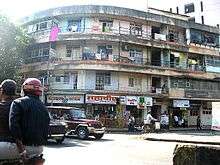Chawl
The chawl (Marathi: चाळ, romanized: cāḷ) is a name for a type of residential building found in the western part of India. Typically, housing units in chawls are availed of by relatively poor but gainfully employed migrant families. Chawls were constructed in abundance during the early 1900s, in the textile mill areas of Mumbai, and indeed this is how they originated, to provide cost-effective housing to mill-workers in Mumbai. They were later built by working-class emigrants working in other manufacturing industries also. This type of housing is no longer built, but remaining structures are still in demand because of their relatively affordable rents.


Description
Building layout
Chawls are residential apartment blocks of a characteristic layout plan. They are typically 4 to 5 storeys tall, with between 8 and 16 tenements on each floor. The tenements are referred to as kholis 'rooms'. A central staircase services the building and gives access to a long passage which runs the length of each floor.[1] A typical feature of chawl architecture is that this long passage is open on one side and has a row of doors on the other side, each door being the entrance to a tenement. Thus, the passage giving access to the tenement provides an open space (a "balcony") where people living in the tenements can come and stand, gaze at the street below, get some fresh air and sunlight and socialize with their neighbours. The fact that all the tenements are ranged on one side of the passage, leaving the other side open to the sky, is a defining feature of chawl architecture. The architectural similarity between all chawls are their balcony structures- these were created so that people could come out of their houses and interact with each other. The balconies form common grounds for people to mingle.
Lifestyle
People living in a chawl have little privacy. Due to the close nature of the quarters, trivial news and gossip travels quickly. On the other hand, however, this intimate living situation also leads to a friendly atmosphere, with support networks akin to familial relationships. People keep their doors open throughout the day and close them late at night.
A chawl life is quite contradictory to what one sees in today's world especially the fact that people are secluded in behavior unlike the one who lives in a chawl. A chawl stimulates interaction among communities, and there is a bridged gap between rich and poor. In today's era a chawl is occupied by several middle-class people including people from different parts of the country. Although there is such a big difference in culture and religious and ethnic backgrounds, people in chawl have still maintained healthy relationships and it is less likely to have disputes between communities. Hence you could find Christians, Hindus, Muslims, Jains, Parsis, etc., all living under the same roof.
Chawls have a unique heritage value. They are good examples that show how peaceful different communities can live with each other. Not only that, neighbours get to learn each other's tradition and cultures and it exposes much learning into religions and beliefs.[3]
In popular culture
The distinctive cultural features that arise from this unique situation have been featured in plays, novels like Q&A by Vikas Swarup (source of Slumdog Millionaire) and films like Katha (1983), a Hindi comedy movie directed by Sai Paranjpye.[4] Caring and sharing is beautifully depicted in Rajshree Productions' movie of 1972, Piya ka Ghar. In the films Vaastav, Bunty aur Bubli and D, the heroes begin their lives in chawls. In the Zee TV soap opera Pavitra Rishta, one of the main characters' families lives in a chawl. In the Colors (TV channel) soap opera Madhubala-Ek Ishq Ek Junoon, the female protagonist's family lives in a chawl. In Mulk Raj Anand's novel Coolie, the central character Munoo lives with two family groups in a chawl in his time in Bombay; there are detailed descriptions of such living circumstances. In the 2019, Marathi-language drama film, 15 August (Marathi: १५ ऑगस्ट), the action revolves around life in a chawl, with the majority of the filming taking place there.
See also
- Cortiço – a term used in Brazil and Portugal for an area of concentrated, high density urban housing, Cortiço houses are typically divided into small rooms that are rented
- Casa di ringhiera a very similar type of housing built in the same period, and for the same purposes in Northern Italy.
- corrala, casa de corredor, or edificación de vecindad, a similar structure typical of Madrid, but also found in some other towns in Castile, as well as in parts of Andalusia and some other cities in Spain.
- corral de comedias, this same structure used as a venue for theater, especially in Madrid during the Spanish Golden Age.
References
- Kamath, Naresh. "There's room for everyone: How Mumbai's chawls have been housing people for 117 years". Hindustan Times. Retrieved 22 August 2019.
- Kamath, Naresh. "There's room for everyone: How Mumbai's chawls have been housing people for 117 years". Hindustan Times. Retrieved 22 August 2019.
- Godbole, Sayli. "What It's Actually Like To Live In A Mumbai Chawl". Homegrown. Retrieved 22 August 2019.
- Katha Internet Movie Database
Further reading
- Karandikar, Priyanka (2010). Chawls: Analysis of a middle class housing type in Mumbai, India (MS thesis). Iowa State University. Retrieved 31 January 2013.
- Sanyal, Tithi (2018). The Chawls and Slums of Mumbai (PDF) (MS thesis).
External links
| Wikimedia Commons has media related to Chawl. |
- Times of India Life in a chawl. 6 February 2011.
- Slate (magazine)/Quora What Is It Like to Live in a Chawl? First person description of growing up in a chawl. 25 June 2013.